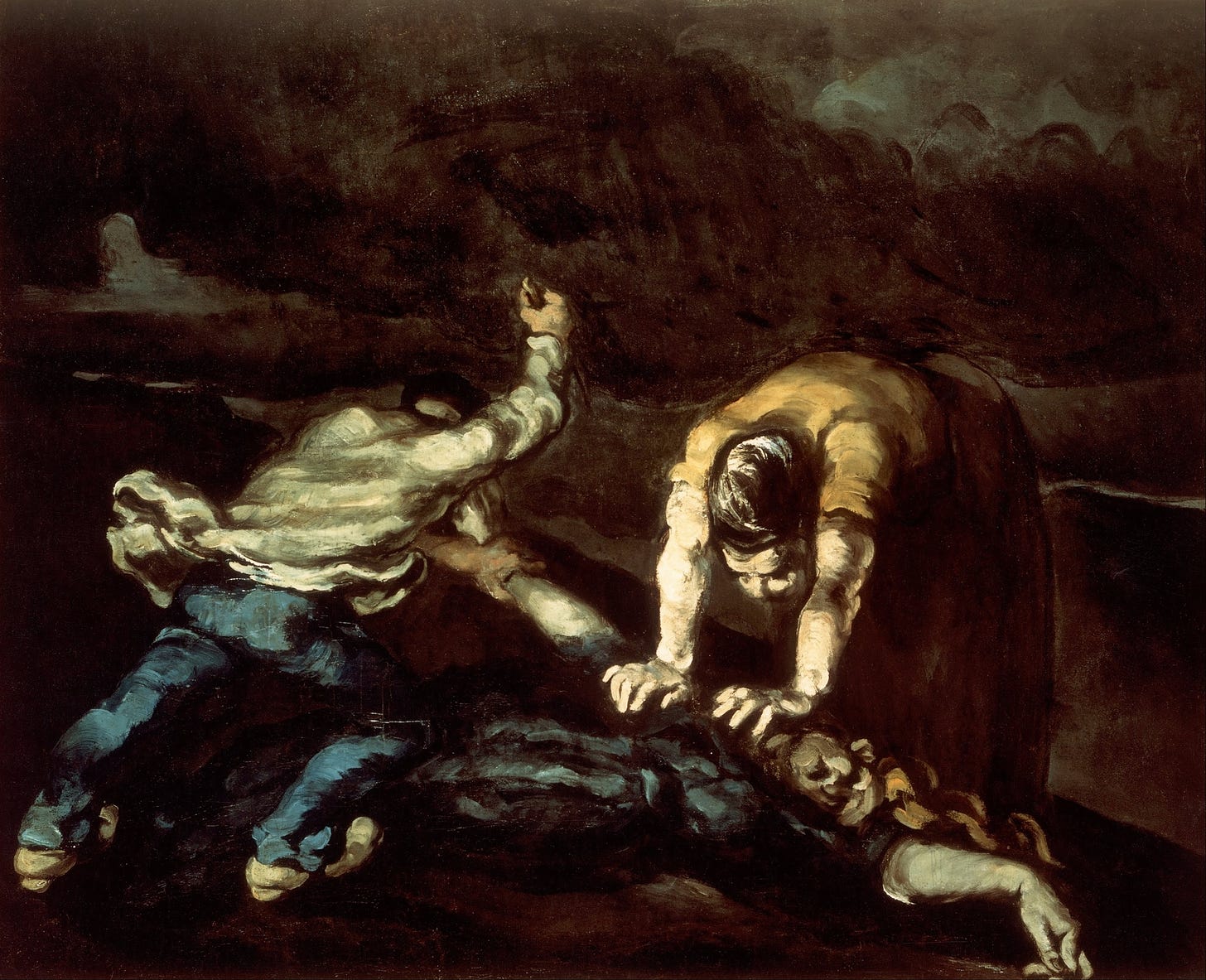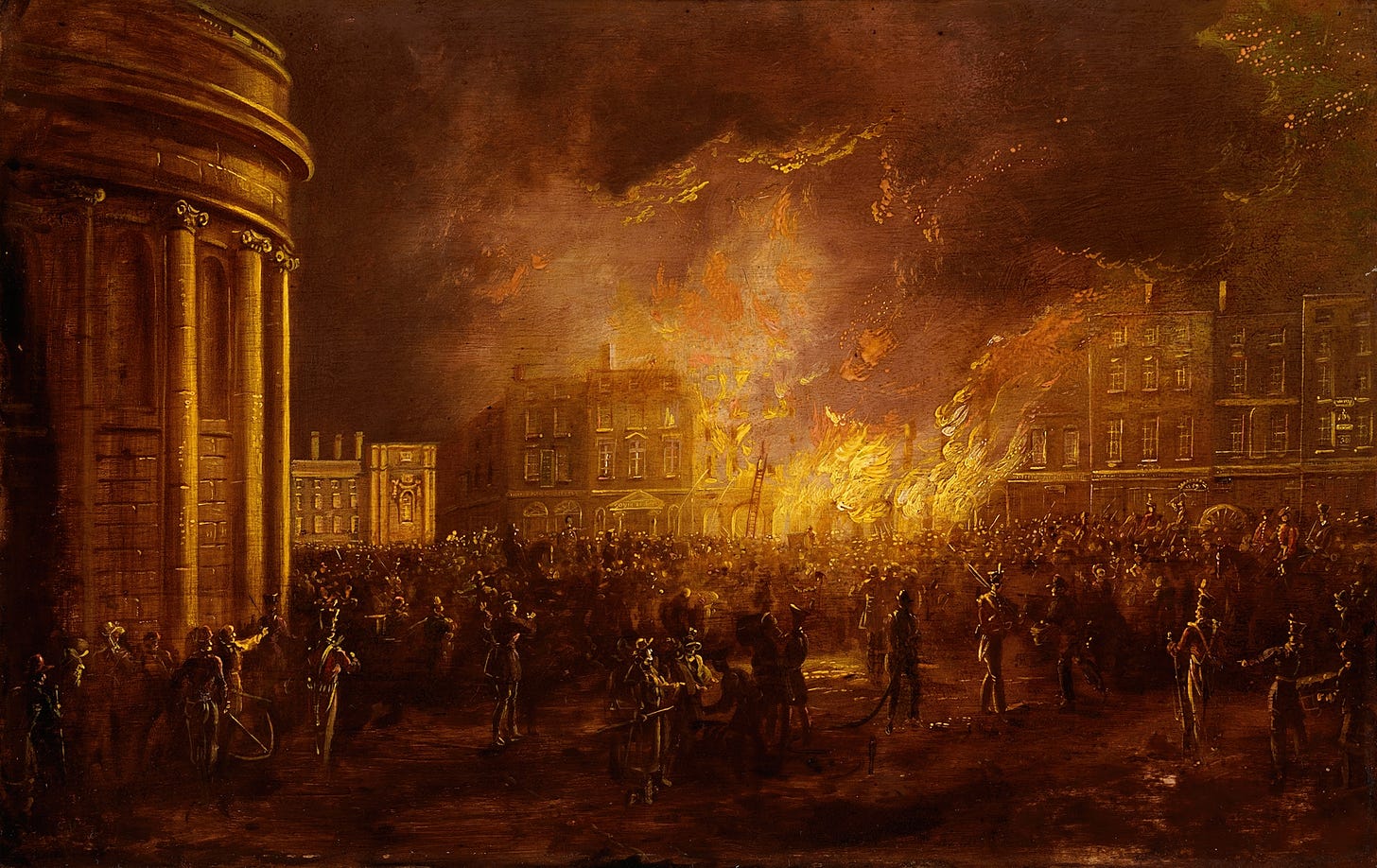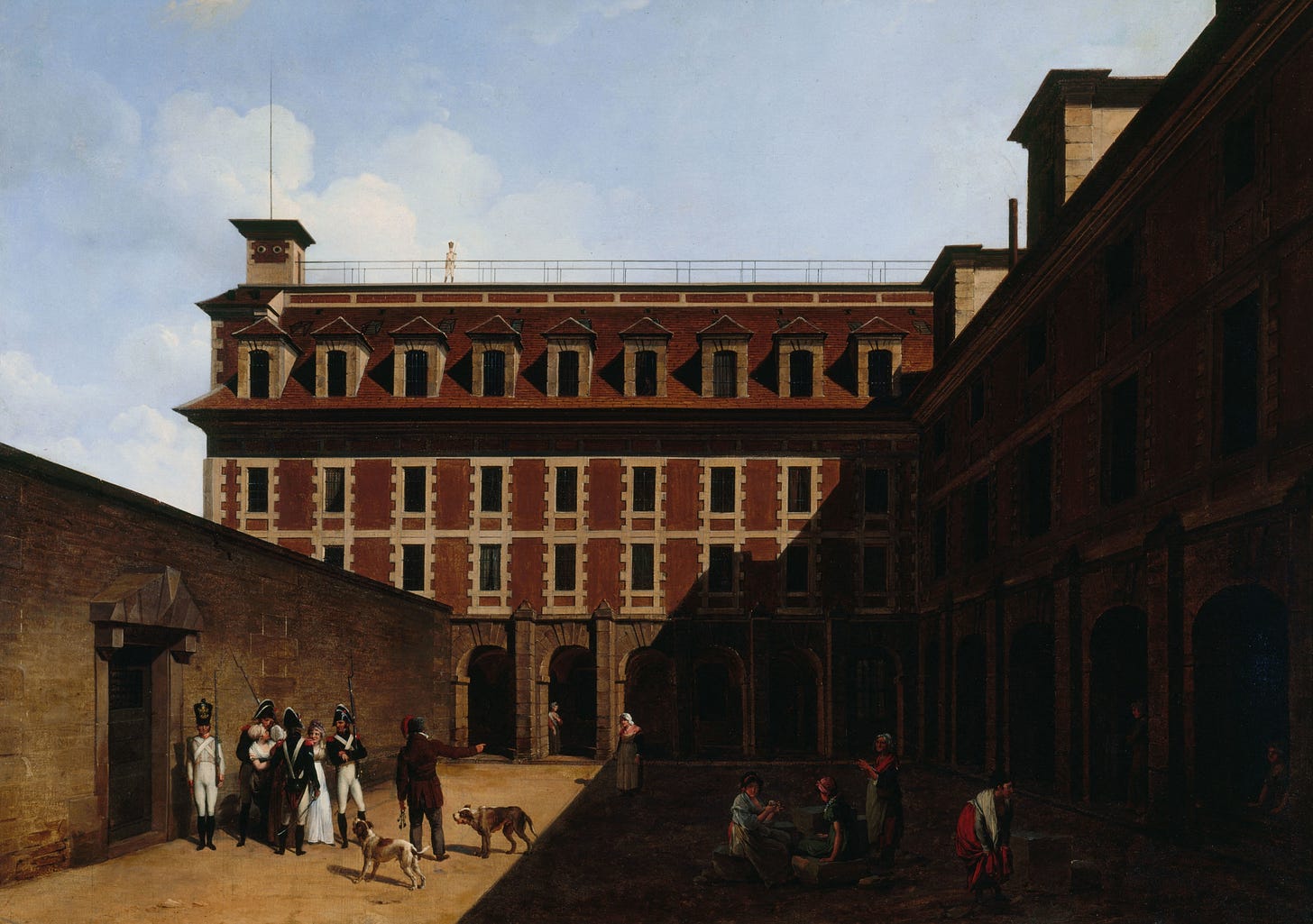The Object of Crime
On Mark O'Connell's A Thread of Violence, Claire Keegan, and the true crime trauma plot
“The Murder", Cézanne, c. 1867-1870
In the summer of 1982, Malcolm Macarthur murdered two people in the vicinity of Dublin. His first victim was Birdie Gardin, a trainee nurse whose car he stole. The second was Donal Dunne, a local farmer whose shotgun Macarthur was going to buy, and ultimately turned on him. The motivation behind each killing was simple: Macarthur was going to rob a bank. Gardin’s car would be his getaway vehicle, and Dunne’s shotgun his weapon of intimidation. The motivation behind that plan is a little harder to parse. Macarthur, the sole benefactor of a significant (but finite) family inheritance, was running out of money. He had become used to a certain kind of lifestyle. How had he come to bank robbery, let alone murder, as the most appropriate manner in which to re-up his finances? Such questions came later. First there was the scandal of his arrest. Macarthur was apprehended by the Garda following a botched robbery of a similarly-wealthy acquaintance — a sort of dress rehearsal for the main event. He was found hiding out at the home of Ireland’s then-Attorney General, a friend from the upper crust world he was so desperate to remain a part of.
It was such a bizarre set of circumstances, and it very nearly brought down the government of the time. The peculiarity of the crimes themselves, too, captured the popular imagination. How had Macarthur, with his Anglo-Irish accent and foppish manner, ended up in a position where these actions made sense? Why did Macarthur do any of this? Then there are the further questions that spring forth from the initial inquiry. Why jump straight to bank robbery to avoid destitution? He had never engaged in criminal activity before. Why kill Bridie or Donal? He could have let them go, having gotten what he wanted. Macarthur presents himself like a puzzle waiting to be cracked.
Early on in his book on Macarthur, A Thread of Violence, Irish essayist Mark O’Connell is chastised by a friend for treating his subject and his motivations as if he were a fictional character:
“‘Listen,’ she said, ‘You’re making a potentially major mistake by thinking of him in this way.
‘What do you mean?’ I said.
‘What I mean,’ she said, ‘is that you need to stop thinking about him as though he’s a character. He’s a real person. He’s a man who did terrible things…What I am saying is that this is about power. You’re talking right now as if you have all the power, in the way that you would if he was in fact a character you had created.’”
In fairness to O’Connell, he is simply working in the mode of the true crime genre. It’s long been about armchair analysis, interpretation, and the presumed power offered by the facts of a case. O’Connell also came to Macarthur from a literary, oblique angle. He wrote his PhD thesis on the work of Irish novelist John Banville, whose 1989 novel The Book of Evidence fictionalises details of the Macarthur case. A Thread of Violence opens with a recounting of a talk given by Banville that O’Connell was present for. It later transpired that Macarthur was also in attendance. The killer was even going around introducing himself to people as the inspiration for a character from the author’s books. Some were shocked by this casual admission, as well as by his presence. Others had no idea who he was or what he was on about.
While the killings were a cause célèbre when they occurred, they have somewhat faded in the popular consciousness. Taoiseach Charles Haughey described the incident contemporaneously (and possibly apocryphally) as “grotesque, unbelievable, bizarre and unprecedented.” It is this phrase — specifically, the acronymized form GUBU — which has lingered, rather than the crimes that inspired them. Coined by journalist and writer Conor Cruise O'Brien, GUBU is invoked to this day in the discussion of Irish political scandals and cock-ups. Were one to Google the case, as I did immediately upon hearing of it for the first time, you might be surprised to find that Macarthur doesn’t have a Wikipedia entry under his own name. The particulars of his case can be found as a subsection of the extant entry for GUBU. Macarthur, and those he killed, are reduced to mere explanatory footnotes in the definition of media-wank terminology. Macarthur, and his victims, were mediated almost immediately as soon as they entered the news cycle.
*
After spending three decades in jail, Macarthur was released on licence for good behaviour. He has since become an eccentric local figure in Dublin, often spotted across town, dressed in a manner redolent of a Wes Anderson character in O’Connell’s telling. He is fitfully papped by photographers; he was interviewed by a particularly daring hack for his opinions on the mask mandates precipitated by the COVID-19 pandemic. O’Connell is moved to track him down upon realising that, alongside the threads of coincidence that had bound their existences together, and besides these rather trivial appearances in the press, Macarthur had never granted any sort of interview regarding the murders. O’Connell makes direct contact with Macarthur by cycling into Dublin city centre and hanging around some of his known haunts, which remain mostly empty during the lockdowns. Mostly; their initial meeting quickly becomes more intimate when Macarthur is confronted by another passerby, facemasked and concealed further behind a camera, aggressively demanding he account for his killing of Gargan. Macarthur suggests the pair move from the street to the lobby of his nearby apartment building.
From here, they begin to meet regularly in Macarthur’s flat, where he initially declines to discuss the “criminal episode,” as he euphemistically refers to it. Macarthur explains that this was a condition of his being released early. Breaking these terms could risk his being returned to jail. Instead they spend much of the book circling the core subject, the only reason Macarthur is notable and the only reason O’Connell would wish to speak to him, without tackling it head on. O’Connell instead talks to his subject about his early life and childhood, his family history, his education and interests. Macarthur is all too ready to redress misconceptions about these subjects that had already been reported in the popular media. He begins one of their meetings with a prepared list of corrections and addendums to subjects they had discussed at their last meeting, “to clear up certain ambiguities.” Even before the intervention of O’Connell’s friend, Macarthur himself is resisting being reduced to an easily-understood character. He dismisses reported instances of discord with his parents, of a head injury in his youth, which had been pointed to as the “cause” of his later behaviour. He does not want to be the subject of a trauma plot.
Words Words Words
In which I waffled on about specificity of language vs looseness, with reference to West Elm Caleb, the rise of therapy speak in our relationships and entertainment, and the dread lingering influence of Your Fave is Problematic in all of this
At the end of 2021 The New Yorker published Parul Sehgal’s essay “The Case Against the Trauma Plot.” It’s my understanding the outlet exists primarily to publish pieces which define the way all writing is discussed for the 18 months or so which follow1. In this case, Sehgal took aim at a certain tendency in contemporary fiction2. We live in an age where the main characters in everything from novels to thoroughly un-prestige television are understood as a collection of hang-ups formed as the result of a core, foundational trauma. Tres Freudian! Not only that, but the stories featuring these characters either include an unearthing of this emotional origin story as a subplot, or even as the main event. Sehgal boils it down to:
“Dress this story up or down: on the page and on the screen, one plot—the trauma plot—has arrived to rule them all. Unlike the marriage plot, the trauma plot does not direct our curiosity toward the future (Will they or won’t they?) but back into the past (What happened to her?).”
Her broader assertion, and one which I am naturally sympathetic to, is that this turn should be considered of a piece with the rise of therapy-speak in public life. She selects Hanya Yanighara’s A Little Life as a case study, the ne plus ultra of this tendency. For the protagonist of that novel, Jude, martyr-like in his constant and repeated tortures, “trauma trumps all other identities, evacuates personality, remakes it in its own image.” In this formulation, trauma is synonymous with backstory, and the excavation of backstory to better understand the actions and behaviours of a character is “plot.” It is what you do in therapy, sort of. Even that is to misunderstand the meaning and utility of the talking cure, though, which (when engaged with most fruitfully by both participants) is a multifarious and ongoing conversation. It’s not, just for a totally random example, a police investigation into a crime, in which there must be a singular perpetrator, and a singular motive, so that justice can be done within the system which we have built to mete it out.
An investigation is still very different to what comes after. Once you’ve decided who is guilty, with that question and the perpetrator each tidily put away, you’re still left with the why. I first heard of this book, and its subject, when the author appeared on “Murder House Sold,” a miniseries spin-off of superior literary podcast SFUltra . Host and poster par excellence Sean McTiernan notes that the author did not use psychiatric language once during the book.3 However, O’Connell does recount a conversation with Macarthur which he didn’t include in the book, where the author outed himself as “basically a Freudian”:
“In the sense that I think we don’t know what we’re saying, we don’t know what we’re doing. We’re controlled, to a large extent, by forces we don’t understand, that we don’t recognise, that are acting within us. And [Macarthur] was kind of really wrong-footed by this, he was like, ‘If I had known you were a Freudian, I don’t think I would have ever agreed to do this, because I do believe that I am fully in control of what I do. I’m entirely self-aware. I know why I do what I do. There are no mysteries to me. Some people might not be aware of the forces that drive them, but I am absolutely fully aware of my mind.’”
In this exchange you perhaps have the book, and the thrust of this whole essay, in a nutshell. O’Connell and Macarthur are jockeying for control throughout. This power dynamic is the subject of constant negotiation throughout A Thread of Violence: between an author and his subject, sure, but also between an author who believes his subject’s motivations must be understandable by delving into their past, and a subject who claims otherwise. It’s much easier to navigate this mire when you’ve created the character yourself. They aren’t in a position to argue.
“The Burning of the Arcade in College Green, Dublin,” William Sadler the Younger, 1873
While reading A Thread of Violence, I also picked up “So Late In The Day,” a cracking short story by O’Connell’s countrywoman Claire Keegan. Recently published in a cynical cash-grab of a slender hardback, the story originally appeared in the pages of, ahem, The New Yorker. “So Late In The Day” follows Cathal, a middle-aged bachelor, as he clocks off from work, travels home, makes dinner, and then cries in front of a television documentary about Princess Diana. What’s all that about? Well, Keegan tells you. Juxtaposed with the banality of his external actions is the tragedy of Cathal’s interior life, through flashbacks. He had a relationship with, and was eventually engaged to, a French woman named Sabine. She eventually left him, owing to an unchecked aggression towards her and women in general, inculcated by his father, his siblings, and also…Society. The seemingly regular evening routine we bore witness to took place on what was supposed to be Cathal and Sabine’s wedding day.
This revelation is teased out with a grace and patience that belies the occasional clunking interruption by the authorial voice explaining what patriarchy is — the working title for the story was, simply, “Misogyny” — and perhaps betrays the story’s origins as an exercise during a writing class. An interview with Keegan appeared alongside the story, where she explains that:
“The story came to me while I was discussing the differences between drama and tension (which are sometimes near-opposites to me) in a fiction-writing workshop. One of my students asked if I could come up with an example of a tense story with little or no drama…I didn’t really know what I was doing in that lesson or where it would lead, but, when I got to the documentary and his sadness, I realised that I was describing this man’s wedding day—the day he was supposed to be married. And that his going to work and coming home were full of tension and loss because of what was not happening.”
Structure is the well from which this particular story sprung, yet its power emanates from the deep emotional tragedy of its subject. Even if he is an arsehole. Keegan attributes particulars of Cathal’s everyday suffering to the fact that “the writer is always looking for someone who’s genuinely ailing or finding it difficult to cope, someone who is out in the deep water.” Back to Seghal: she’s not arguing against the traumatised character in fiction. Far from it. It’s the trauma plot which is regarded, rightly, with suspicion. Cathal as a man cannot be understood solely and completely through the incident which has undeniably rocked him (i.e. being jilted). However, it’s through the interior life Keegan has created that we can understand the particular vignette we witness. Even this small slice of his life concertinas out to include the formative experiences which informed the hang ups, behaviours and prejudices that would go on to wreck his adult relationships. “It’s unfair to judge people on their appearance as central characters in a short story,” Keegan asserts. “They may very well be at their worst.”
Seghal’s critique of the trauma plot echoes many criticisms of the true crime genre. Why do we want to know more about the life stories of murderers? Do we think we can actually hope to understand them? As much as reading these things is the result of a morbid curiosity, it’s also a way of pinning the criminals to a board, keeping them in place for examination whilst also causing them physical pain. To rake over their crimes is to, at least theoretically, have them return to the defining incident(s) of their existence. In Macarthur’s case, he was “at his worst” in Keegan’s formulation during this singular episode of violence, which he insists is distinct from the rest of his moral life. At this present moment, when true crime as a genre is really popping off, there is a certain received wisdom I consider to be complete horseshit.
The argument goes that it’s fine to indulge in grisly subject matter, just so long as these books, TV shows, podcasts, or whatever, do not valorise the criminals. Instead, they must centre their victims in the narrative. Their stories must be returned to them, having been robbed by their killers. Can you believe that Hays Code baloney? I believe this is, by and large, a convenient method through which to whitewash the baldly exploitative intentions of performatively drunk comedians and Netflix documentary commissioners who make a living monetising the pain of others. Examples that have actually, successfully centred the victims are few and far between4 and besides finding the intention dubious in the extreme from the rest of them, I’d question the results as well.
Flattening a murderer, trapping them into an eternal purgatory in the pages of a book or the thinness of a screen, may be granting them and their case a lack of dimension, but it can feel like a fitting punishment. What other possible justification is there for putting the victims, and their families, of Jeffrey Dahmer into a fucking Ryan Murphy show? O’Connell expresses his own scepticism towards this thinking, as he errs from detailing Gargan’s life, and the effect of her untimely death on her family:
“A writer who wants to produce something more than mere exploitation is under an ethical obligation to tell the story of the victims. They must not be reduced to a series of disembodied wounds, like images in a forensic pathology textbook. They must have names and faces. They must have stories. It was, in this sense, my intention to give Bridie Gargan and Donal Dunne a faithful portrayal in these pages.
“And yet, the more I try this, the more wrong it feels. The story I am telling is about Malcolm Macarthur, and Bridie Gargan and Donal Dunne had nothing to do with him other than the grave misfortune of their encountering him during his criminal spree. They were not the victims of a serial killer, selected on the basis of some or other aspect of their identity. Their deaths were, in a deep and crucial sense, a violent aberration from the context of their lives.”
When you write a character in a story, you’re hoping to somehow conjure multidimensionality from nothing. When you put a real person into a book, you flatten them between the pages, the way a flower is pressed. In preserving them, you’re crushing them, killing them. O’Connell reflects further on his conversation with his friend, guilty not only for his thinking of Macarthur as a Raskolnikov or Meursault figure, but how that implicates his victims also:
“My tendency to think of Macarthur as a character, and of his crimes as constituting a bizarre and compelling story of human perversity — a story about class and Irish history, about cruelty and repression — was itself a kind of heartlessness. Because if Macarthur was a character, and his crimes were a story, then his victims were necessarily characters too, and secondary ones at that.”
“La Prison Des Madelonnettes, Rue Des Fontaines,” Louis Léopold Boilly, 1810
It’s perhaps not a “spoiler,” if such a thing is possible for a work of non-fiction — if such a thing matters, for adults whose interest in a book is not simply a literary peek-a-boo, hidden conclusions revealed after a period of time to their great delight — to say that O’Connell doesn’t get answers from Macarthur. He was never going to. That’s sort of the point. Numerous explanations for his “criminal episode” are tried on throughout A Thread of Violence, and are found wanting. Michael McDowell, a barrister on his defence team who later became ministry of justice,5 argued that his client had lost his footing within a mist of “moral blindness.” Macarthur himself insists that, were one to plot his moral life on a graph, it would be a straight line, with the “criminal episode” being the only blip.
O’Connell muses that, in his recounting of the killings, it becomes hard not to picture Macarthur “as a weird, malfunctioning robot.” Several psychiatric professionals apparently referred to this affect as “automatonism.” But Macarthur is not a robot; he is a human being. In a less charitable, and perhaps more clear-eyed, assessment, O’Connell at another point puts Macarthur’s fixity of purpose down to his desire to maintain his life of unemployed leisure, an impossibility he refused to acknowledge and drove him to a “narcissistic rage”:
“I cannot help but think, that is, that although the violence was carried out in service of a fiction, it was realer than anything he had done in his life.”
Soon after, the author alights on his ultimate conclusion about Macarthur, the case, and his own desire to interpret a meaning from each. He is not a fictional character. The words which make up the bare existence of individuals like Cathal are the entirety of it. You can know them completely. They do not carry on doing things when you close the book, or exit the web page. There is nothing more to learn. It’s all there on the page — for better or worse — to interpret. It’s not possible to fully know a real, breathing individual in this way. The endeavour is as doomed to failure in this context as any other.
“I know him. I have walked around the city with him. I have felt a buzz of a call in my pocket as I dressed my daughter for bed, and seen his name on the screen of my phone, and felt an uncanny chill of transgression. I have seen his hands, still well kempt, and his teeth, no longer good or white. I don’t know what he is, other than a man. I don’t know what he is, other than what he did.”
It’s been a while, hey? Hopefully we’ll be seeing a lot more of each other. In the meantime, if you enjoyed this, pretty please do share far and wide; it’s the only way to build an audience, I hear. What if you wrote a six-page true crime essay and nobody came? Doesn’t bear thinking about, does it.
The film adaptation of Cat Person is in cinemas now, I’m told!
And, naturally, compared it unfavourably to the popular non-contemporary fiction which preceded it
Something which critics appear to have largely missed; McTiernan notes that the Irish Times review opened with a Freud quote
Honestly, it might just be Hallie Rubenhold’s The Five, which tells the stories of the women killed by Jack the Ripper, and that’s it
At which point had to recuse himself from the decision of whether Macarthur might receive probation




